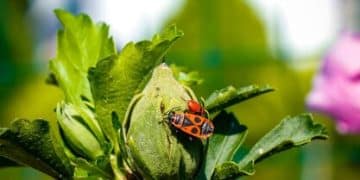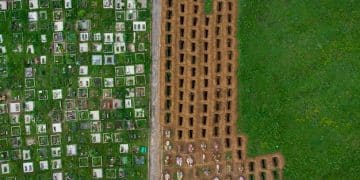Sustainable Landscaping: Water-Saving, Wildlife-Friendly Yards
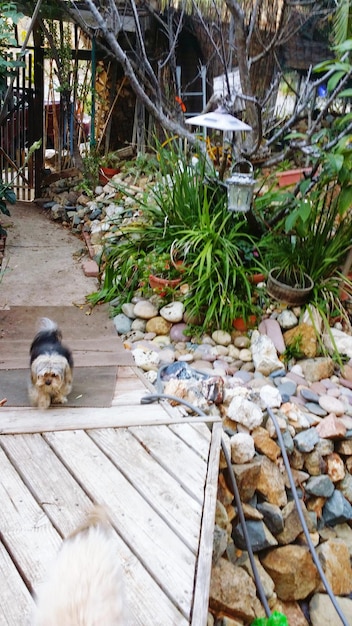
Sustainable landscaping offers an innovative approach to creating beautiful, resilient outdoor spaces that minimize water consumption, reduce waste, and actively support local ecosystems, fostering biodiversity and ecological balance in your own backyard.
Creating a beautiful, thriving outdoor space doesn’t have to come at the expense of environmental well-being. In fact, the principles of sustainable landscaping: create a beautiful yard that conserves water and supports wildlife offer a harmonious path to achieving both. This approach moves beyond purely aesthetic considerations, embracing ecological balance, resource conservation, and the cultivation of vibrant, healthy ecosystems right in our own backyards. It’s about designing landscapes that are not only visually appealing but also actively contribute to a healthier planet, one garden at a time.
The Core Principles of Sustainable Landscaping
Sustainable landscaping is more than just a trend; it’s a comprehensive philosophy that integrates ecological responsibility with aesthetic appeal. At its heart, it’s about creating landscapes that function efficiently, require minimal inputs, and support the natural world. This approach considers every element of a yard, from the plants chosen to the permeable surfaces installed, all aimed at fostering a balanced and resilient ecosystem.
Water Conservation Techniques
One of the most critical aspects of sustainable landscaping is intelligent water management. Traditional lawns and gardens often consume vast amounts of water, an increasingly scarce resource. Implementing water-saving strategies is paramount, not only for environmental reasons but also for reducing utility bills. Techniques like xeriscaping, which focuses on drought-tolerant plants, are central to this philosophy. Rainwater harvesting systems, such as rain barrels or cisterns, collect precipitation for later use, reducing reliance on municipal water sources. Furthermore, efficient irrigation methods, like drip irrigation, deliver water directly to plant roots, minimizing evaporation and runoff. Grouping plants with similar water needs together helps optimize watering schedules and prevents overwatering or underwatering certain areas.
- Xeriscaping: Utilizing drought-tolerant plants adapted to local climate conditions.
- Rainwater Harvesting: Collecting and storing rainwater for irrigation.
- Efficient Irrigation: Employing drip irrigation or soaker hoses to minimize water loss.
Supporting Local Wildlife and Biodiversity
A truly sustainable landscape goes beyond just saving water; it actively invites and supports local wildlife. By providing food, water, shelter, and breeding sites, landowners can transform their yards into vital habitats. Native plants are crucial here, as they have evolved alongside local fauna and offer the specific resources that insects, birds, and small mammals need. These plants often require less maintenance, water, and fertilizer because they are naturally adapted to the local environment. Integrating diverse plant species, including trees, shrubs, and perennials, creates a layered habitat that caters to different wildlife needs, fostering a rich tapestry of life. Avoiding pesticides and herbicides is also vital, as these chemicals can harm beneficial insects and birds, disrupting the delicate food web.
Maintaining a sustainable garden also involves understanding the role of various species within the ecosystem. For example, some insects are pollinators, crucial for plant reproduction, while others act as natural pest control. Providing diverse flowering plants throughout the growing season ensures a continuous food source for pollinators. A small pond or bird bath can offer a much-needed water source, especially during dry periods. Furthermore, leaving certain areas a bit “unkempt,” with leaf litter or brush piles, can provide shelter and nesting sites for beneficial insects and small animals.
Designing Your Sustainable Landscape: From Concept to Creation
The design phase of sustainable landscaping is where vision meets ecological principles. It’s an opportunity to create a space that is not only beautiful and functional but also minimizes environmental impact. This involves careful planning that considers local climate, soil conditions, and the specific needs of the homeowner and the ecosystem.
Site Analysis and Planning
Before any digging begins, a thorough site analysis is essential. Understanding your yard’s unique characteristics—such as sun exposure, soil type, drainage patterns, and existing vegetation—is fundamental. Knowing where the sun falls at different times of day, where water tends to collect, and what type of soil you have will inform your plant choices and design layout. For instance, plants that thrive in full sun should be placed in areas receiving at least six hours of direct sunlight, while shade-lovers should find their place under existing trees or structures. Soil testing can reveal nutrient deficiencies or pH imbalances, guiding soil amendments that promote healthy plant growth without excessive chemical reliance.
- Sunlight Mapping: Identify areas with full sun, partial sun, and shade.
- Soil Testing: Determine soil type, pH, and nutrient content to select appropriate plants.
- Drainage Assessment: Observe how water flows and pools to plan for efficient water management.
Selecting Native Plants and Drought-Tolerant Species
The cornerstone of a successful sustainable landscape is the conscious selection of plants. Native plants are adapted to your local climate and soil conditions, meaning they often require less water, fertilizer, and pest control. They also provide essential food and habitat for local wildlife, supporting a healthy ecosystem. Complementing native species with other drought-tolerant plants ensures your landscape remains vibrant even during dry periods. Researching local plant nurseries and botanical gardens can provide valuable insights into suitable species for your region. Prioritizing diversity in your plant selection also contributes to a more resilient and attractive landscape, offering varying textures, colors, and bloom times.
Consider the mature size of plants when planning to avoid overcrowding and reduce the need for extensive pruning. Layering plants—using groundcovers, perennials, shrubs, and trees—creates a dynamic visual appeal while also maximizing habitat opportunities for wildlife. For instance, a dense understory of shrubs can provide nesting sites for birds, while tall trees offer roosting spots and shade. Selecting plants that bloom at different times throughout the year ensures a continuous source of nectar and pollen for pollinators, keeping your garden buzzing with life.
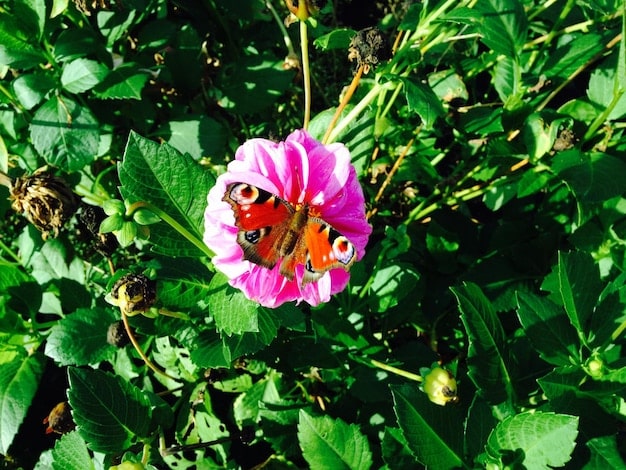
Implementing Sustainable Practices: Installation and Maintenance
Once the design is complete and plants are selected, the next phase involves the careful implementation and ongoing maintenance of your sustainable landscape. This stage focuses on minimizing resource use, reducing waste, and nurturing a healthy environment through responsible practices.
Smart Irrigation and Water Management Systems
Efficient water use is critical. Beyond choosing drought-tolerant plants, implementing smart irrigation systems can significantly cut down on water waste. Drip irrigation, for example, delivers water directly to the root zone, minimizing evaporation and surface runoff. Smart controllers that adjust watering schedules based on local weather conditions, soil moisture, and plant needs can further optimize water use, preventing overwatering during rainy periods. Regularly checking for and repairing leaks in irrigation systems is also a simple yet effective way to conserve water.
Beyond traditional irrigation, integrating natural water features like rain gardens or swales can manage stormwater runoff on-site. Rain gardens are shallow depressions planted with water-loving native species that absorb and filter rainwater, preventing it from overwhelming storm drains and reducing pollution. Swales, which are long, shallow ditches, slow down and spread out water flow, allowing it to infiltrate the soil rather than run off. These features not only conserve water but also help replenish groundwater and improve water quality, demonstrating a holistic approach to water management.
Soil Health and Organic Fertilization
Healthy soil is the foundation of any thriving garden, especially in a sustainable landscape. Instead of relying on synthetic fertilizers, which can pollute waterways and harm soil microorganisms, focus on building rich, living soil through organic matter. Composting kitchen scraps and yard waste creates nutrient-rich material that improves soil structure, water retention, and microbial activity. Adding compost annually enhances fertility naturally, supports beneficial earthworms and microorganisms, and reduces the need for external inputs.
Cover crops, planted in off-seasons, can further protect and enrich the soil by preventing erosion, suppressing weeds, and adding organic matter when tilled back into the ground. Mulching around plants with organic materials like wood chips or shredded leaves helps retain soil moisture, regulate soil temperature, suppress weeds, and slowly break down to contribute to soil health. These practices reduce the need for excessive watering and chemical treatments, fostering a naturally resilient and productive garden ecosystem.
- Composting: Creating nutrient-rich soil amendments from organic waste.
- Mulching: Applying organic material to conserve moisture and suppress weeds.
- Cover Cropping: Planting specific crops to enhance soil health and fertility.
Reducing Waste and Embracing Ecological Stewardship
A core tenet of sustainable landscaping is minimizing waste and promoting a circular system where resources are reused and recycled within the landscape itself. This approach extends beyond plant choices to encompass all aspects of garden management, from material selection to waste disposal.
Composting and Recycling Yard Waste
Instead of sending yard waste to landfills, sustainable landscaping encourages on-site composting. Grass clippings, fallen leaves, pruned branches, and spent plant material can all be transformed into valuable compost, which then enriches your garden soil. This not only diverts waste but also closes the loop, returning nutrients to the earth naturally. For larger branches or wood, chipping can create mulch, further reducing waste and providing a beneficial ground cover. Creating a dedicated compost pile or bin is a simple step that yields significant environmental benefits, reducing the need for costly external soil amendments and contributing to overall soil health.
Beyond yard waste, considering the materials used in hardscaping elements, such as patios or pathways, is also important. Opting for recycled or permeable materials, like recycled pavers or gravel, reduces demand for virgin resources and allows water to infiltrate the ground, preventing runoff. Even old bricks or broken concrete can find new life as decorative elements or sub-base for new structures, further minimizing waste and giving unique character to your landscape. This thoughtful selection of materials contributes to a landscape that is both beautiful and environmentally responsible.
Minimizing Chemical Use: Natural Pest and Disease Control
One of the most impactful aspects of sustainable landscaping is the drastic reduction, or complete elimination, of chemical pesticides, herbicides, and synthetic fertilizers. These chemicals can harm beneficial insects, birds, and other wildlife, contaminate water sources, and deplete soil health. Instead, sustainable practices rely on natural methods for managing pests and diseases.
Encouraging beneficial insects, such as ladybugs and lacewings, which prey on common garden pests, is a primary strategy. This can be achieved by planting a diverse range of flowering plants that provide nectar and pollen for these helpful predators. Companion planting, where certain plants are grown together to deter pests or attract beneficial insects, is another effective technique. For instance, marigolds can deter nematodes, while dill can attract parasitic wasps that prey on aphids. Maintaining robust plant health through proper watering, soil amendments, and appropriate plant selection also makes plants more resistant to pests and diseases, reducing the need for interventions.
- Beneficial Insect Attraction: Planting flowers that attract natural pest predators.
- Integrated Pest Management (IPM): Using a combination of cultural, biological, and physical controls to manage pests.
- Organic Solutions: Employing natural remedies like neem oil or insecticidal soaps as a last resort.
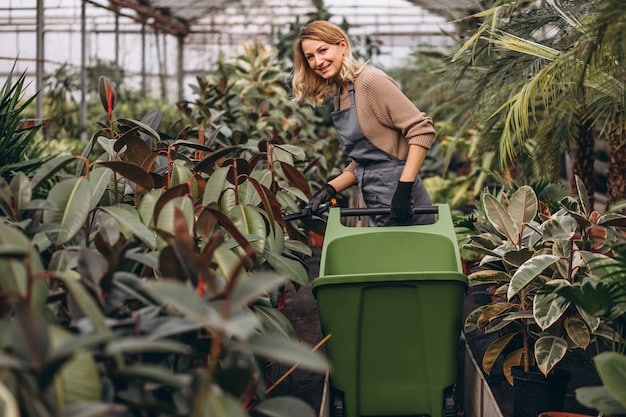
Beyond the Garden: Community Impact and Education
Sustainable landscaping extends its benefits beyond individual property lines. By adopting these practices, homeowners become part of a larger movement that fosters environmental stewardship, educates communities, and contributes to regional ecological health. The collective impact of many sustainable landscapes can lead to significant positive change.
Creating Green Corridors and Habitat Networks
When multiple homes in a neighborhood adopt sustainable landscaping practices, they collectively create “green corridors” that provide continuous habitat and movement pathways for wildlife. These interconnected green spaces are crucial for biodiversity, allowing animals to move safely between different areas, access food and water, and find mates. Even small, urban yards can contribute by planting native species, installing bird baths, and avoiding pesticides, linking up with other green spaces like parks or nature preserves. This network effect enhances ecological resilience across an entire community.
Community-wide education plays a vital role in expanding these green networks. Hosting workshops, sharing resources, and demonstrating successful sustainable landscaping techniques can inspire neighbors to make similar choices. Seeing tangible results—more birds, butterflies, and healthier plants—can be a powerful motivator. Local initiatives, such as native plant sales or garden tours showcasing sustainable designs, can further build momentum and collective action. This collaborative effort transforms isolated yards into a dynamic, interconnected ecosystem that benefits both nature and people.
Educating and Engaging the Community
Sharing knowledge and inspiring others is a fundamental aspect of sustainable living. Educating neighbors, friends, and local organizations about the benefits and practicalities of sustainable landscaping can multiply its positive impact. Workshops on native plant selection, rainwater harvesting, or composting can empower individuals with the skills to transform their own spaces. Local garden clubs, community centers, and schools are excellent venues for disseminating this information, fostering a collective commitment to environmental health.
Demonstration gardens in public spaces can serve as living examples of sustainable landscaping principles. These visible projects can showcase the beauty and functionality of water-wise plants, permeable pathways, and wildlife-friendly features, dispelling myths about sustainable landscapes being unattractive or difficult to maintain. By actively engaging the community in these efforts, sustainable landscaping transcends individual action, becoming a widespread movement that builds environmental literacy and fosters a deeper connection to the local ecosystem.
The journey towards sustainable landscaping is a continuous process of learning and adaptation. It’s about working with nature, rather than against it, to create outdoor spaces that are not only aesthetically pleasing but also economically efficient and ecologically beneficial. By embracing techniques that conserve water, support biodiversity, and reduce waste, we contribute to a healthier planet and a more vibrant future, one yard at a time. The benefits extend far beyond personal enjoyment, fostering resilient ecosystems and inspiring a deeper connection to the natural world around us.
From the initial conceptualization and careful planning of your outdoor space to the ongoing implementation of mindful maintenance practices, every step in sustainable landscaping contributes to a larger environmental good. It transforms the conventional idea of a yard into a dynamic micro-ecosystem, where water is cherished, wildlife thrives, and chemical reliance becomes a thing of the past. The choices we make in our gardens cascade into broader ecological impacts, reflecting a commitment to living in harmony with our natural surroundings. This holistic approach not only beautifies our immediate environment but also plays a crucial role in conserving vital resources and maintaining the delicate balance of our planet’s ecosystems.
| Key Point | Brief Description |
|---|---|
| 💧 Water Conservation | Implement xeriscaping, efficient irrigation, and rainwater harvesting to minimize water use. |
| 🦋 Wildlife Support | Choose native plants to provide food, water, and shelter for local flora and fauna. |
| 🌱 Soil Health | Use composting and mulching to enrich soil naturally, avoiding synthetic chemicals. |
| ♻️ Waste Reduction | Recycle yard waste, use permeable materials, and minimize chemicals for a healthier yard. |
Frequently Asked Questions About Sustainable Landscaping
Xeriscaping is a landscaping method focused on reducing or eliminating the need for irrigation. It primarily involves selecting drought-tolerant plants native to the region, optimizing soil health to maximize water retention, and designing landscapes that group plants with similar water needs. This approach significantly conserves water by relying on natural rainfall and reducing supplemental watering, making it ideal for arid or semi-arid climates.
Native plants are crucial for sustainable landscaping because they are inherently adapted to local climate, soil, and environmental conditions. This adaptation means they generally require less water, fertilizer, and pest control compared to non-native species. More importantly, native plants provide essential food and habitat for local wildlife, including pollinators like bees and butterflies, contributing to biodiversity and supporting regional ecosystems, creating a balanced and resilient landscape.
Supporting wildlife in your sustainable yard involves providing food, water, and shelter. Plant a diverse range of native plants to offer nectar, pollen, and seeds. Install a bird bath or a small pond for a water source. Create shelter by incorporating dense shrubs, brush piles, or leaving some leaf litter. Avoiding pesticides and herbicides is also vital, as these chemicals can harm beneficial insects and birds, ensuring a safe and flourishing habitat.
Composting in a sustainable landscape offers numerous benefits. It diverts organic waste from landfills, reducing methane emissions. The resulting compost enriches soil with vital nutrients, improving its structure and water retention capacity, which lessens the need for synthetic fertilizers and frequent watering. Compost also fosters a healthy soil microbiome, promoting beneficial organisms and making plants more robust and resilient against pests and diseases, creating a self-sustaining system.
While the initial transition to sustainable landscaping might involve some upfront planning and investment, it’s not inherently difficult or more expensive in the long run. Many sustainable practices, such as choosing native plants and creating compost, actually save money on water bills, fertilizers, and pest control over time. Moreover, with proper design and plant selection, sustainable landscapes can be low-maintenance and highly resilient, ultimately reducing ongoing costs and effort.
Final Thoughts on Cultivating Sustainable Outdoor Spaces
Embracing sustainable landscaping is a transformative journey that profoundly impacts both our immediate environment and the broader ecological system. It’s an invitation to shift our perspective from simply maintaining a yard to actively nurturing a dynamic, living ecosystem that benefits everyone. By consciously choosing water-wise plants, fostering biodiversity, and minimizing our ecological footprint, we move beyond conventional gardening. This approach empowers us to craft outdoor spaces that are not only stunning but also resilient, requiring fewer resources and offering a haven for wildlife. It stands as a testament to the idea that beauty and ecological responsibility can, and should, coexist, inspiring a new paradigm for how we interact with the natural world right outside our doors. The commitment to sustainable landscaping signifies a powerful step towards a more harmonious and enduring relationship with nature.


